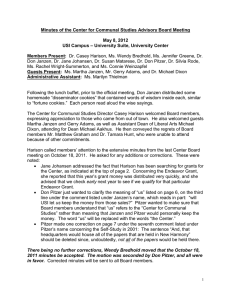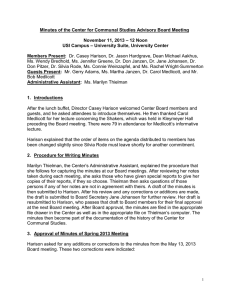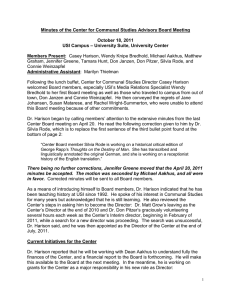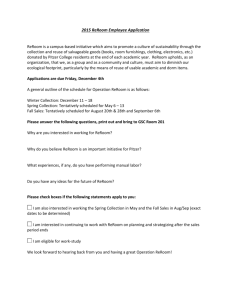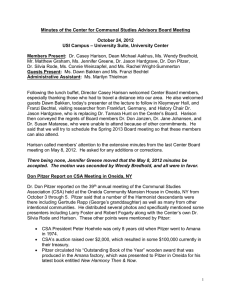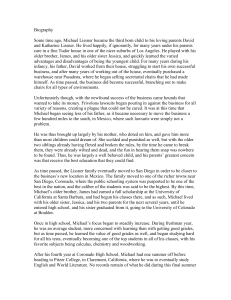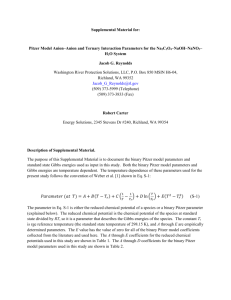Minutes of the Center for Communal Studies Advisory Board Meeting
advertisement
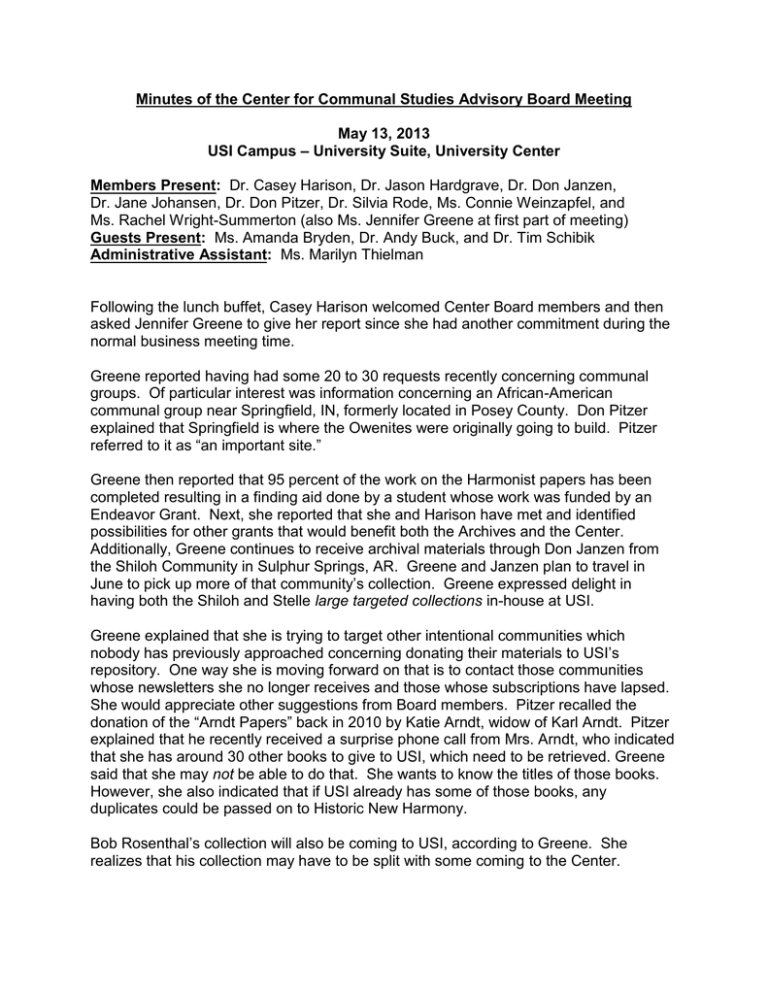
Minutes of the Center for Communal Studies Advisory Board Meeting May 13, 2013 USI Campus – University Suite, University Center Members Present: Dr. Casey Harison, Dr. Jason Hardgrave, Dr. Don Janzen, Dr. Jane Johansen, Dr. Don Pitzer, Dr. Silvia Rode, Ms. Connie Weinzapfel, and Ms. Rachel Wright-Summerton (also Ms. Jennifer Greene at first part of meeting) Guests Present: Ms. Amanda Bryden, Dr. Andy Buck, and Dr. Tim Schibik Administrative Assistant: Ms. Marilyn Thielman Following the lunch buffet, Casey Harison welcomed Center Board members and then asked Jennifer Greene to give her report since she had another commitment during the normal business meeting time. Greene reported having had some 20 to 30 requests recently concerning communal groups. Of particular interest was information concerning an African-American communal group near Springfield, IN, formerly located in Posey County. Don Pitzer explained that Springfield is where the Owenites were originally going to build. Pitzer referred to it as “an important site.” Greene then reported that 95 percent of the work on the Harmonist papers has been completed resulting in a finding aid done by a student whose work was funded by an Endeavor Grant. Next, she reported that she and Harison have met and identified possibilities for other grants that would benefit both the Archives and the Center. Additionally, Greene continues to receive archival materials through Don Janzen from the Shiloh Community in Sulphur Springs, AR. Greene and Janzen plan to travel in June to pick up more of that community’s collection. Greene expressed delight in having both the Shiloh and Stelle large targeted collections in-house at USI. Greene explained that she is trying to target other intentional communities which nobody has previously approached concerning donating their materials to USI’s repository. One way she is moving forward on that is to contact those communities whose newsletters she no longer receives and those whose subscriptions have lapsed. She would appreciate other suggestions from Board members. Pitzer recalled the donation of the “Arndt Papers” back in 2010 by Katie Arndt, widow of Karl Arndt. Pitzer explained that he recently received a surprise phone call from Mrs. Arndt, who indicated that she has around 30 other books to give to USI, which need to be retrieved. Greene said that she may not be able to do that. She wants to know the titles of those books. However, she also indicated that if USI already has some of those books, any duplicates could be passed on to Historic New Harmony. Bob Rosenthal’s collection will also be coming to USI, according to Greene. She realizes that his collection may have to be split with some coming to the Center. Rachel Wright-Summerton explained that USI will eventually be the repository of Padanaram’s collection as well. Wright-Summerton said that she is currently working on two books about Padanaram, getting advice from Pitzer, Janzen, and Rosenthal. 1. Introductions Harison thanked Greene for her report as she left the meeting. He then conveyed the regrets of Susan Matarese and Wendy Bredhold, who were unable to attend today’s meeting. Additionally, Harison reported that Matthew Graham will no longer be on the Board of the Center, his term having expired. He also explained that Dean Michael Aakhus is currently in Africa, and Associate Dean Michael Dixon could possibly join the meeting later. Harison then welcomed these guests: Amanda Bryden, Collections Manager in New Harmony, along with USI Professors Andy Buck and Tim Schibik, who are on the Program Committee for the 2014 New Harmony Conference on Capitalism and Socialism. Bryden’s recent project has been digitizing some 30,000 slides of New Harmony, which should soon be available since 3,000 have now been completed. 2. Approval of Minutes of Center Board Meeting of October 24, 2012 Harison asked for approval of the extensive minutes from the last Center Board of Advisors meeting. He asked for any additions or corrections. There being none, Don Janzen moved that the October 24, 2012, minutes be accepted. The motion was seconded by Connie Weinzapfel, and all were in favor. 3. Center Annual Report Harison called members’ attention to the Center’s Annual Report for 2012-2013 which was included in the handouts, and then he highlighted certain information and also gave updates: Harison wants to revive the Speaker Series for the Center, and he has the support of Dean Aakhus. Many speakers deal with American communes, and he is seeking suggestions from Board members of names and means of financial support for those speakers. Weinzapfel said that many speakers are being contacted for the Bicentennial in New Harmony. Perhaps some of those who cannot come in August would be available for the Center at another time. Weinzapfel and Harison will pursue this further. Concerning the Speaker Series, Harison said that Dr. Stephen Zehr, Professor of Sociology, had an excellent turnout for his talk concerning “The Place of Villages in Sustainable Development” in March. Harison is considering Carol Medlicott, author of a new book entitled Issachar Bates: A Shaker’s Journey, as a future speaker. Pitzer suggested having Janzen showcase the spectacular Shiloh collection sometime in the future since members were pioneers in the organic food industry. Harison will be working at the Center through mid-June. He is currently working on the Call for Papers for the 2014 New Harmony Conference. The Program Committee for that conference will tour New Harmony on May 24 to see the facilities and lunch together at the Red Geranium. Next week Franzi Bechtel, 2010 Center Research Travel Grant winner from Frankfurt, Germany, will again come to USI and New Harmony to continue research for her dissertation. Last August, Polish scholar Magdalena Modrzejewska researched at the Center and the Archives as well as at New Harmony’s Working Men’s Institute. Harison said that we need to make the Center more accommodating to foreign visitors. It is hard to find appropriate and affordable housing for them along with their car expense. In the future, the Center needs to encourage a guest house available near campus and travel accommodations to and from New Harmony and campus. Weinzapfel suggested inviting Mr. Ryan Rokicki, the new director of Working Men’s Institute, as a guest to the Center’s fall Board meeting; he may have ideas concerning guest accommodations. Harison indicated that other matters in the Center’s Annual Report will be covered in the balance of items listed on today’s agenda. 4. Center Undergraduate and Graduate Prizes; Center Research Travel Grant Harison called attention to the awards for best Undergraduate Paper and Graduate Paper as listed under item #4 in the Annual Report. He also said that the recipient of the Research Travel Grant will be announced in the next week or so. He asked that the Board approve the decisions of the judges for all three of these awards. Connie Weinzapfel moved that the final decisions of the judges for the 2013 Graduate and Undergraduate Paper Prizes and the Research Travel Grant be accepted. The motion was seconded by Silvia Rode, and all were in favor. Harison will list these three awards on the Center’s website and also in the Communal Studies Association’s newsletter. 5. Report: Marilyn Thielman Marilyn Thielman, the Center’s administrative assistant, reported details about the three students, hand-picked by Harison, whose services in the Center from mid-January through early April were covered by $2,200 funding provided by the Provost’s Office. Chris Purk, Michael Harris, and Kyle Coates are all history majors, who have taken classes taught by Harison. The student workers helped to organize much of the Center’s materials available for research purposes. Purk, though confined to a wheel chair with muscular dystrophy, developed a finding aid for some 450 books. Harris created a finding aid for some 170 DVDs – many converted earlier from old VHS tapes – and saved both the DVDs and VHS tapes along with many hand-written notes from Director Emeritus Pitzer; these DVDs are exclusive to the Center rather than the Archives. Coates transcribed six of the 70 90-minutes oral interviews from the 1960s, began four other transcriptions, and developed a database for all 354 interviews done by Tim Miller for his book entitled The 60s Communes – Hippies and Beyond. Some of Coates’ work has continued to be done gratis after the funding was exhausted; he calls it a “learning experience.” The major accomplishments by these three student workers will prove invaluable to future researchers in the Center. Pitzer addressed the value of these students’ contributions as well. At the conclusion of the students’ work time for the Center, Harison provided lunch in the Center for Pitzer and his wife Connie Pitzer along with Thielman and a fourth student worker, John Sureck, whose work in the Archives was covered by an Endeavor grant. Pitzer complimented the students’ efforts in tackling this major reorganization of the Center’s resource materials. He also felt that the students would be helpful in participating in a “think tank” when it came to other suggestions concerning the Center’s resources for researchers. Harison reported that Coates had also done some initial work on information for the Center’s website and Facebook. Harison will work with USI’s website staff to add to Coates’ beginning effort. Weinzapfel also suggested putting some of the Center’s information on New Harmony’s website. Concerning Facebook in general, other Board members agreed with the value of having students participate in entering information. Jane Johansen stated that a great deal of work has already been produced that can be linked to it. 6. Report: Rachel Wright-Summerton Rachel Wright-Summerton circulated photos of Padanaram taken over the years. She then shared some comparisons between earlier days and the current community in Padanaram. The young families are now building very large individual homes. Some twenty-five to thirty-five couples in their 30s and 40s plan to stay in the community and raise their families there. Schools will probably be started again with Wright-Summerton teaching once more. Some facilities that were shut down in the late 1990s will be updated and running again. Many buildings are being remodeled and revamped. The future of Padanaram is in the hands of these new community members according to Wright-Summerton, whose upcoming books should be very enlightening. 7. Report: Silvia Rode Silvia Rode presented Utopias Made in German at the University of Louisville, sponsored by the Hite Art Institute lecture series on “Art, Thinking, & Social Change,” and the honors program, March, 2013. This fall, she will offer a graduate course on Utopia as part of the M.A. in Liberal Studies. Harison reported that he will offer a class at the senior level on European Origins of Utopia in spring, 2014. He said that a goal is to eventually hire someone with real expertise in that area. Andy Buck confirmed that there has been a revival of interest within the last five years concerning the subject of utopia in the areas of sociology and anthropology. Tim Schibik echoed that there is a resurgence concerning the idea of the working community – labor movements in the nineteenth and twentieth centuries. Pitzer stated that community is necessary in almost any course – music or whatever. 8. Report: Don Janzen Don Janzen’s report focused on several points. First, he indicated that he has been using the Shiloh community’s choice of USI as a repository for their community’s materials as an entrance into other Christian communities that may be considering an archival repository. He specifically mentioned having been in contact with Sheperdsfield Community in Fulton, Missouri, and Lost Valley in Dexter, Oregon. Janzen said that he has been contacted by Dr. Matt Grow, the Center’s former director, who is interested in displaying on the Communal Studies Association website some of the intentional community framed collages that Janzen had given to the Center in the past, particularly those showing the individual community signs and their older homes. Janzen’s concern is to know how to designate that they are the property of USI and permission was given to display them on CSA’s website. He also wanted some clarification concerning whether those collages were in fact considered to be a gift to the Center or to the USI Archival Collection since he had given them to Jennifer Greene at the Rice Library although they are currently displayed in the Center. Much discussion followed concerning ownership rights and responsibilities regarding previous donations, and it then evolved into clarification of what should actually be listed on the Center’s website. Janzen said that he has a goal of increasing his contributions to the Center (or the Archives). His thought was listing on the Center’s website something like “Essays on Communities and Cooperative Literature.” Janzen referenced Tim Miller’s new 600-page book which lists 3,000 intentional communities. There are certain communities that Janzen has visited which are not included in Miller’s listing. Some photos of those communities are part of Janzen’s donation to USI’s Special Collections. There is currently no place to publish incidental information that Janzen has about those communities in his database or some corrections to current information published by Miller or others who have not visited those communities as Janzen has or old and new information that none but Janzen actually knows. More discussion continued. Harison wondered whom this information would target. If it were students, researchers, or anyone writing a paper or working on a future book, they could be directed to the Center’s website for additional information. Pitzer commented that he personally spent some 20 years gathering information before publishing his book on communal societies. Janzen said that he is trying to think of some way to promote the Center in the best way. Harison said that Greene, who was unable to stay for today’s meeting, needs to be involved in these discussions as well. These two motions then evolved: Motion #1: Don Janzen moved that the Center create a section on their website devoted to retrievable data on historic and current cooperative communities. The motion was seconded by Don Pitzer, and all were in favor. Motion #2: Don Janzen moved that the Center would have a link to Communal Studies published and unpublished research. The motion was seconded by Jane Johansen, and all were in favor. 9. Report: Don Pitzer Pitzer reported on recent and pending publications and book reviews in the field of communal studies. He reminded us that Eileen Aiken English’s excellent reference work titled Demographic Directory of the Harmony Society appeared in 2011 from the Richard W. Couper Press and his own review stressing its usefulness was in the 2012 CSA journal Communal Societies (Vol. 32, No. 2). He further said that he was honored to write an introduction for the 2012 reprint of Backwoods Utopias, Arthur Bestor’s classic study of the Owenite phase of communitarian socialism. Because Bestor had become his mentor, Bestor was given an honorary doctorate from USI in 1988, and he sent many items from his communal research to our archives. Don Janzen’s review of Don Pitzer and Darryl Jones’s 2011 New Harmony Then and Now, which got the 2012 CSA Book Publication Award, was in Communal Societies journal (Vol. 32, No. 1). The anthology of original essays Pitzer edited in 1997 titled America’s Communal Utopias has been used widely as a textbook, and this year became an e-book from its publisher North Carolina University Press. The royalties from this book have always been given to the CSA, and those of the digital version will continue to be donated this same way. Three major books already have appeared in 2013 and another is due out yet this year. Tim Miller’s latest reference book, The Encyclopedia of American Intentional Communities from Richard Couper Press, is being reviewed by Don Janzen for Communal Societies journal. The Communal Idea in the 21st Century is an anthology of essays, several written by people known to the Center and edited by three Israeli scholars including our friend and ICSA founder Yaacov Oved. Published by Brill Press, it contains Pitzer’s chapter “Developmental Communalism into the Twenty-First Century” that presents evidence to show an ultimate stage of communal development from the voluntary communal experiments since the 1960s. Their progressive ideas, ideals, and innovations are becoming integrated into the general society worldwide. Pitzer credits one of Janzen’s current communitarian contacts, Omni Mountainskyrainbow, who lives in the communal Mothership Sanctuary near Eugene, Oregon, for inspiring the chapter’s central point. Omni has made astute observations on the transformation of many aspects of society in the direction of proven communal “Petrie dish” experiments such as in healthier eating habits. In his chapter, Pitzer quoted her assertion, “We are the mainstream culture of the future! And the future is here.” Also in 2013, Yaacov Oved’s wide-ranging Globalization of Communes 1950-2010 was printed by Transaction Press with appraisals by Tim Miller and Don Pitzer on the jacket. The Companion to Alternative Organisation is a volume of invited essays edited by professors in England and America pending publication this year by Routledge Press. Pitzer’s chapter on “Communes and Intentional Communities” puts the advantages and disadvantages of communal organization in historical perspective and presents three case studies—Don Janzen’s on The Shiloh Family that pioneered American organic foods in agriculture, baked goods, and marketing; Docey Lewis’s on her fabric enterprise she calls “micro-philanthrocapitalism” in a kinship community in Ndem, Senegal; and Rachel Wright-Summerton’s on the internally cooperative and externally competitive organization of the Padanaram Settlement near Bedford, Indiana, where she is a founding member. Two noteworthy articles appeared in the April 2013 issue of the Southwestern Historical Quarterly (Vol. CXVI, No. 4). These are José María Herrera, “Visions of a Utopian Texas: Robert Owen’s Colonization Scheme” and Donald J. Kagay, “Icaria: An Aborted Utopia on the Texas Frontier.” Also, never to be overlooked are the articles appearing in Communal Societies, the American Communal Societies Quarterly, Utopian Studies, and Communities: Life in Cooperative Culture. Pitzer also reported that he has been asked to give a brief address at the Dedication Ceremony of the 1876 Centennial School Model, which will be held in Rice Library on May 16. The Centennial School building on 12th Avenue was the location of the first classes offered by Indiana State University Evansville that became USI in 1985. He was asked to speak as the only living history professor to have taught there. He arrived in June 1967, a month before Dr. David Rice who would become USI’s first president, and just two years after classes began and two years before the opening of the current campus. He will describe the inspiring long-range vision of offering public higher education to first generation college students that attracted him and other faculty to the decrepit conditions of Centennial School. He will email copies of his address to the Center and USI archives. 10. By-Laws Jane Johansen will chair the By-Laws Committee and give a report at the fall Board meeting. 11. Other Items and Announcements There being no further discussion or announcements, Harison thanked Board members for their attendance and individual input. The meeting adjourned around 1:30 p.m. Respectfully submitted, Marilyn Thielman, Scribe
